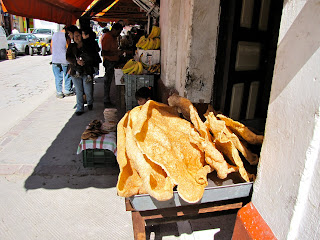There's nothing like a Florida beach for flat as most Leveler travelers know, though the build-up of resorts and condos has added many a step and stair between you and the shore.
Not so on Longboat Key, one of Florida's west coast islets connected by bridges to each other and the mainland. Here you can still find cottages and cabins three-four steps above ground level and at least one motel with no steps.
Anyone who vacationed along the Florida shore in the '50s or '60s is guaranteed a case of deja vu.
Units come with sleeping, sitting, dining and kitchen areas, tiny bathrooms and tile floors. Nothing fancy but what you'll need for a family-type beach vacation. There's always a neighbor who's been here before who can point you to the grocery store and good restaurants.
Then there's the resident white egret that stalks lizards and ambles up and down the central sidewalk like an amiable snoop. Sit still on your patio and it will come to see what you are eating or drinking. Open your room door and it will come in for a breath of air conditioning.
If you want to feel like family, walk across the street to the Blue Dolphin Cafe for breakfast or lunch. It's where the natives go and the staff will know your name and beverage preferences when you come back. It's instant access to the inside track of what to see, do, eat and where to do it best.
What to see. Nearby is the Longboat Key Center for the Arts with exhibits and classes during the season - November to March. At the south end of the key there's the Mote Marine Aquarium.
Cross the bridge to the south onto St. Armands and Lido Keys, which John Ringling North of circus fame once owned, and you'll find fabulous homes, chic upscale shopping and dining at St. Armands Circle. The Walking Company, the largest retailer of comfort shoes, is where I found MBTs (!) on sale. Do take a minute to look at the bronze plaques that circle the park around which the shops and restaurants are positioned. Each one pays homage to a famous circus performer or family and is a history of that athletic art form.
Across the bridge to the north is Anna Maria Island, a conglomeration of sometimes hippy, sometimes mod and a lot of Jimmy Buffetish kick-back, have-a-beer, chill out and grab some rays attitude. There's a lot to explore on foot and many a saloon to relax in.
For 75 cents the Trolley will take you from one end to the other but remember, you're at the beach and schedules are just for appearances.
Across the bay is Sarasota with its Ringling complex of Art Museum, circus in miniature, gardens, circus memorabilia and wagons and Ca d'Zan, John and Mabel's Venetian-inspired mansion.
Tip: There's a lot of walking in every building so save yourself and wait for the shuttle to take you from one to the other.
If you're into the arts you'll be in high sea oats in Sarasota with theater, galleries, dance and interesting architecture galore.
 What to do. You are in a water and sand paradise and you have to ask? Rent a scooter, take a boat ride (Liquid Limousine Charters can fix you up), canoe or kayak, go para-sailing, try your hand at onshore or offshore fishing (Cap'n Mark Gore's the man to call for that).
What to do. You are in a water and sand paradise and you have to ask? Rent a scooter, take a boat ride (Liquid Limousine Charters can fix you up), canoe or kayak, go para-sailing, try your hand at onshore or offshore fishing (Cap'n Mark Gore's the man to call for that).Dining? Everywhere you look there's a treat or three, especially if it's stone crab season. In addition to the Blue Dolphin Cafe, here are a few to get you started.
Ed Chiles, son of the late Florida governor Walkin' Lawton Chiles, has three restaurants that have become local institutions. On Anna Maria Island you can sift sand through your toes at either the Sandbar Restaurant (north end) or the Beachhouse Restaurant (south end). On the north end of Longboat Key in historic Longboat Village is Mar Vista Dockside Restaurant and Pub, a quaint dining room with a dock under which the big fish congregate to nibble on little fish.
Harry's Continental Kitchens can provide anything from fine wine and fresh produce to catering and fine dining morning, noon and night. The German Apple Pancake at brunch is not to be missed.
Euphemia Haye may be the most lauded restaurant in the area and possibly the whole state, with good reason. In an intimate, congenial atmosphere, Chef Ray Arpke and his wife D'Arcy create culinary wonders.
Tip: It's well worth climbing the stairs to the Haye Loft to see and taste the remarkable desserts. Go to Food Afar - Recipes from a Travel Writer to see what's in their famous Apple Walnut Pie.
 Holding down one wedge of St. Armands Circle is Columbia, where crowds flock for the Spanish/Cuban cuisine Casimiro Hernandez Sr. made famous at the original, 1905 Columbia in Tampa's Ybor City.
Holding down one wedge of St. Armands Circle is Columbia, where crowds flock for the Spanish/Cuban cuisine Casimiro Hernandez Sr. made famous at the original, 1905 Columbia in Tampa's Ybor City.That should keep you going before and after the sun sets. Leia Mais…

















































